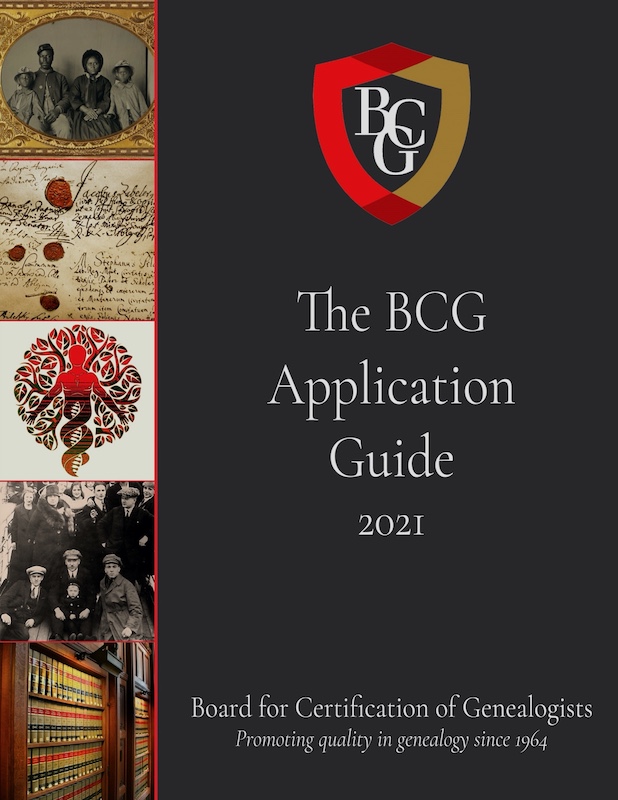How do family historians know they are producing or receiving trustworthy results? This official manual from the Board of Certification for Genealogists, essentially a users’ guide for family historians, provides standards for genealogical researchers to assess their own and others’ work. First published in 2014, Genealogy Standards begins with the simple fact that accuracy is fundamental to genealogical research. Without it, a family’s history would be fiction. That first edition of the manual presented the standards family historians use to obtain valid results, updated, clarified, consolidated, and expanded for the 21st century, and tied more directly to the Genealogical Proof Standard. Responding to this decade’s spate of advancements in the practice of genetic genealogy, the 2019 edition modified four existing standards and added seven new standards to guide the use of DNA evidence in genealogical analysis. It also updated the Genealogist’s Code to address the protection of individuals who provide DNA samples. The revised second edition increases the clarity of DNA and privacy standards. Those standards are especially useful in the twenty-first century when many genealogists use a complex new tool—DNA testing—and trace living people more often than they did in the past.
Board for Certification of Genealogists, Genealogy Standards, second edition revised (Nashville, TN: Ancestry, 2021).
Note: As an Amazon Associate, BCG earns a commission from purchases using the link on this page.
The Amazon listing states that the version they sell is dated 2019. It is not. The item you will receive is the 2021 edition.
Contents
INTRODUCTION TO THE SECOND EDITION
INTRODUCTION TO THE FIRST EDITION
CHAPTER 1—THE GENEALOGICAL PROOF STANDARD
CHAPTER 2—STANDARDS FOR DOCUMENTING
1. Scope
2. Specificity
3. Purposes
4. Citation uses
5. Citation elements
6. Format
7. Shortcuts
8. Separation safeguards
CHAPTER 3—STANDARDS FOR RESEARCHING PLANNING RESEARCH
PLANNING RESEARCH
9. Planned research
10. Effective research questions
11. Sound basis
12. Broad context
13. Source-based content
14. Topical breadth
15. Efficient sequence
16. Flexibility
17. Extent
18. Terminating the plan
COLLECTING DATA
19. Data-collection scope
20. Careful handling
21. Respect for source caretakers
22. Using others’ work
23. Reading handwriting
24. Understanding meanings
25. Note-taking content
26. Distinction between content and comments
27. Note-taking objectivity
28. Images and printouts
29. Transcriptions
30. Abstracts
31. Quotations
32. Transcribing, abstracting, and quoting principles
33. Paraphrases and summaries
34. Agents
35. Source analysis
36. Information analysis
REASONING FROM EVIDENCE
37. Sources, information, and evidence
38. Source preference
39. Information preference
40. Evidence mining
41. Evidence scope
42. Evidence discrimination
43. Evidence integrity
44. Evidence reliability
45. Assumptions
46. Evidence independence
47. Evidence correlation
48. Resolving evidence inconsistencies
49. Unresolved evidence inconsistencies
50. Assembling conclusions from evidence
USING DNA EVIDENCE
51. Planning DNA tests
52. Analyzing DNA test results
53. Extent of DNA evidence
54. Sufficient verifiable data
55. Integrating DNA and documentary evidence
56. Conclusions about genetic relationships
57. Respect for privacy rights
CHAPTER 4—STANDARDS FOR WRITING GENEALOGICAL PROOFS
58. Research scope
59. Proved conclusions
60. Selection of appropriate options
61. Logical organization
ASSEMBLED RESEARCH RESULTS
62. Integrity and ownership
63. Honesty
64. Background information
65. Content
66. Proofs included
67. Overall format
68. Structure
69. Clear writing
70. Technically correct writing
71. Cross-referencing
72. Genealogical formats
73. Biographical information
SPECIAL-USE GENEALOGICAL PRODUCTS
74. Reports
75. Lineage-society applications
76. Source guides
77. Methodology guides
78. Compiled abstracts
79. Reviews
80. Database programs
CHAPTER 5—STANDARDS FOR GENEALOGICAL EDUCATORS LECTURERS AND INSTRUCTORS
81. Planned outcomes
82. Content titles
83. Enhancements
84. Bibliographies
85. Presentation style
86. Ownership
87. Course design
88. Student evaluation
CHAPTER 6—STANDARDS FOR CONTINUING EDUCATION
KNOWLEDGE AND SKILL DEVELOPMENT
89. Development goals
90. Regular engagement
Appendix A—THE GENEALOGIST’S CODE OF ETHICS
TO PROTECT THE PUBLIC
TO PROTECT THE CLIENT (PAYING OR PRO BONO)
TO PROTECT THE PROFESSION
TO PROTECT PEOPLE WHO PROVIDE DNA SAMPLES
Appendix B—ABOUT THE BOARD FOR CERTIFICATION OF GENEALOGISTS
PUBLICATIONS
EDUCATIONAL ACTIVITIES
CERTIFICATION PROGRAM
ORGANIZATIONAL STRUCTURE
BCG’s ADDRESSES
APPENDIX C—SOURCES AND RESOURCES
SOURCE MATERIAL AND RELATED READINGS
RESOURCES FOR EXAMPLES
APPENDIX D—GLOSSARY
EVIDENCE ANALYSIS: A RESEARCH PROCESS MAP


